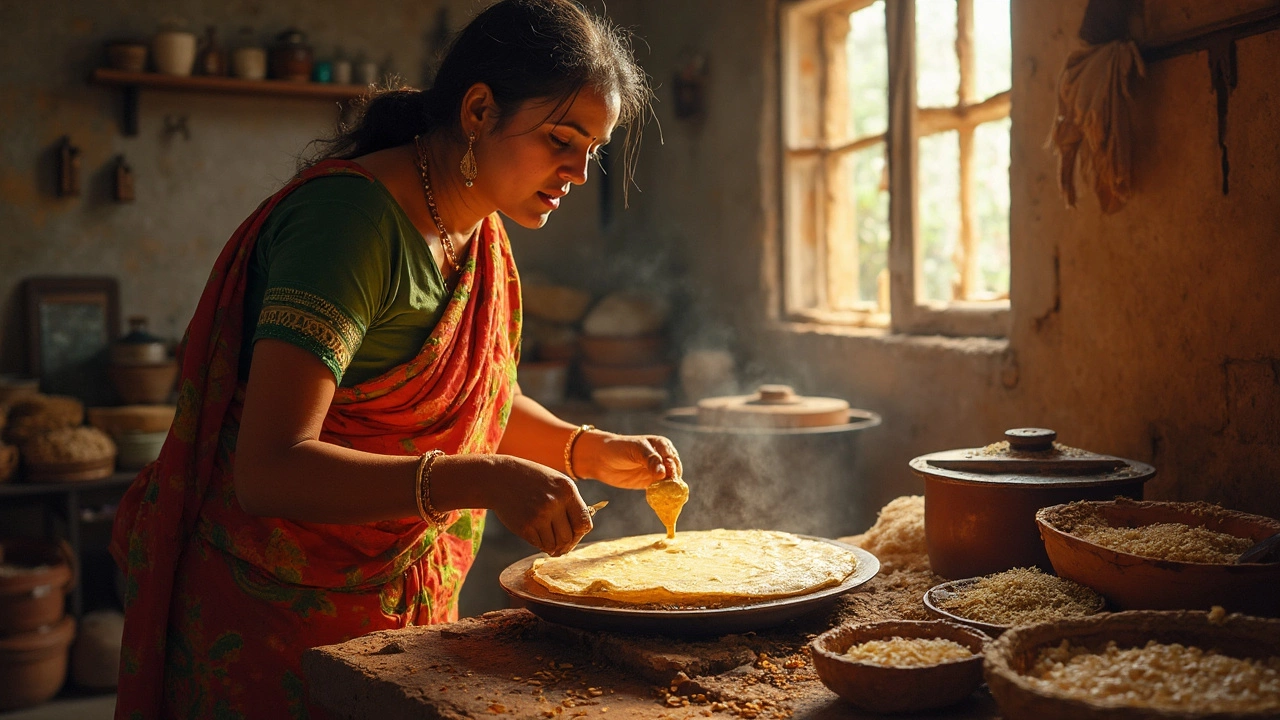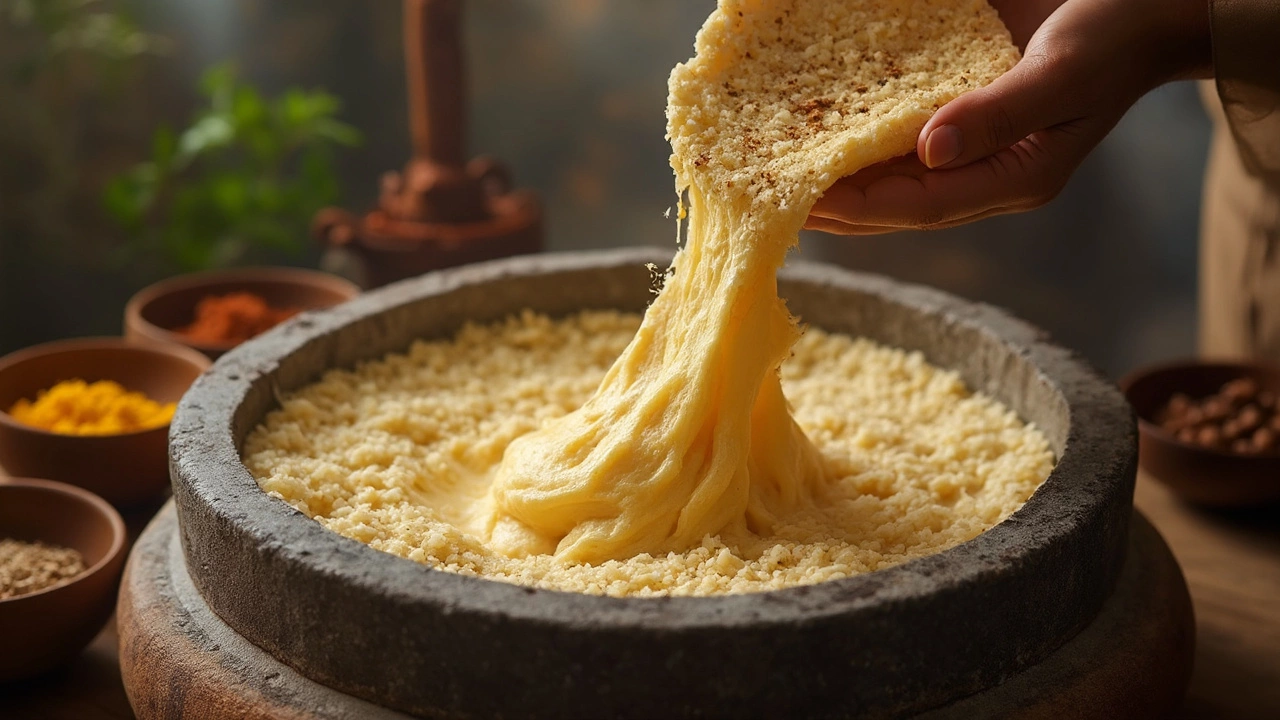Quickly Ferment Dosa Batter Without Yeast
 Feb, 18 2025
Feb, 18 2025
Dosa, a South Indian staple, is more than just a dish—it's a delightful crunch and a subtle tang in each bite. The magic lies in the batter, and getting it just right often means lots of patience and a dash of chemistry. But did you know you can speed ferment your dosa batter without any yeast?
First up, let's chat about the basics. Dosa batter is primarily a mix of rice and urad dal (black gram). A good ratio is key—many folks swear by one part dal to three parts rice. But what if patience isn't your virtue? Well, the secret actually lies in your environment.
To speed things up, warmth is your best friend. Think of your batter as a sun-loving tourist. The warmer the spot, the faster the fermentation. If you're blessed with a warm climate, you're already halfway there. But for those of us in cooler areas, placing the batter in your oven (with just the light turned on) or using a heating pad can work wonders.
- Understanding Dosa Batter Basics
- Speeding Up Fermentation Naturally
- Hacks for Warmer Conditions
- Maintaining Batter Quality
Understanding Dosa Batter Basics
The journey to perfect dosas starts with the batter. Traditionally, dosa batter is a mix of rice and urad dal, both soaked separately, then ground and combined. So, why these ingredients? Well, rice gives the dosa its crispy edge, while urad dal ensures it doesn’t crumble in the pan.
Finding the right balance is crucial. A common and favored ratio is three parts rice to one part urad dal. But some prefer to add a touch of fenugreek seeds for an extra kick of flavor and to aid fermentation.
The Soaking Process
Soaking is not just a step; it’s a game-changer. For the best results, soak rice and dal separately for about 4-6 hours. This softens them, making them easier to grind, and sets the stage for that beloved fermentation.
Grinding to Perfection
Once soaked, it’s time to grind. Many traditionalists prefer a stone grinder, but a mixer works just as well. The goal is a smooth batter for rice and a fluffy mix for urad dal. Once combined, it should be quite thick, like pancake batter, but with a slightly grainy texture.
Letting It Rest
After mixing, let your batter rest covered, allowing the natural enzymes and bacteria to work their magic. This natural fermentation not only gives dosas their unique tangy flavor but also enhances nutritional value.
If you're new to making dosas, remember, it's okay to experiment. Your personal touch might just lead to a homegrown recipe that's uniquely yours!
Speeding Up Fermentation Naturally
Getting your dosa fermentation on fast track is about creating the perfect conditions for those little bacteria and yeast naturally present in the grains to do their magic. Let's get into the nitty-gritty of how you can make this happen naturally, without resorting to yeast that can sometimes alter the taste.
Keep It Warm
Temperature plays a huge role in fermentation. If you want to quick dosa batter results, aim for warmth. A cozy corner in your kitchen will do, but if it’s nippy outside, use these hacks:
- Oven Method: Pop your bowl of batter in the oven with the light on. It provides just enough heat to encourage fermentation without cooking the batter.
- Heating Pad: Wrap your bowl in a blanket and place it on a heating pad on the lowest setting. Check every couple of hours to ensure it’s not overheating.
Add a Little Helper
While the grains have their natural yeasts, sometimes they need a little boost. Adding a handful of soaked poha or a tablespoon of ragi flour can kickstart the process.
Blend Smartly
The smoother the batter, the better it ferments. When blending, try to achieve a texture that’s silky and lump-free. This increases surface area exposure and helps in faster fermentation.
Watch The Clock
Ferment without yeast doesn't mean waiting forever. In optimal conditions, four to six hours should do the trick. But keep a nose out for that slight sour aroma—a clear sign that your batter’s ready to roll!

Hacks for Warmer Conditions
Getting your dosa batter to ferment quickly really benefits from having a warm environment. If you don't already live in a tropical paradise, there are still some tricks you can use to mimic those conditions.
Make Use of Your Oven
A great way to create a warm spot is by using your oven. No need to turn up the heat though, just use it as a cozy space! Simply switch on the oven light, not the heat itself. The gentle warmth from the bulb can provide the perfect temperature for your dosa fermentation. It might sound quirky, but it works wonders!
Embrace the Heating Pad
If you've got a heating pad lying around, it's time to put it to culinary use. Place your batter container on the heating pad set at a low temperature. This direct warmth speeds up the fermentation process efficiently. Just make sure it's evenly distributed to prevent any hotspots.
Sunny Window Magic
Got a sunny window? That's nature's own warming hack. During the day, place your batter beside the window to catch some of those sunrays. It's not only energy-efficient but also keeps your kitchen naturally light and productive.
Use a Thermal Wrap
If none of the above is an option, thermal wraps or blankets can create a warm environment for your dosa batter. Wrap the batter container snugly and let it sit in peace. This may sound low-tech, but it traps the warmth from the initial mixing and helps maintain it.
By using these simple hacks, even the coolest climates can become a friendly environment for speed fermenting dosa batter. Happy cooking!
Maintaining Batter Quality
Keeping your dosa batter fresh and ready for the perfect dosa is like caring for a good pet—it needs your attention and a little love. Here’s how you can ensure your batter remains top-notch until the last drop.
Storage Techniques
Once your batter is fermented, it's crucial to store it properly to keep its quality intact. Place the container in the fridge to slow down further fermentation. But always use an airtight container to prevent any foreign odors from affecting your batter's delicate flavor.
Consistent Texture
Before you make a dosa, give the batter a good stir. This ensures the consistency is uniform. If you’ve stored it for a while, you might find it too thick. In such cases, adding a little water right before cooking can bring it back to dosa-friendly consistency.
Check for Signs of Over-Fermentation
If you notice a strong sour smell or a frothy layer on top, your batter might have over-fermented. Fear not, though—add a spoonful of rice flour and a pinch of salt to balance the taste before making dosas.
"A perfectly fermented dosa batter is the secret to that tantalizing aroma and texture," says renowned chef Vikram Vij. "It's an art passed down through generations."
Reusing Leftover Batter
Leftover batter can sometimes surprise us with its versatility. Transform it by adding finely chopped veggies to create delightful uttapams. Or, mix in some besan (chickpea flour) for a slightly different twist. Always ensure these variants maintain a smooth consistency.
Quick Recovery Tips
Ran out of batter but need to prep for a dosa fix? Create a small batch with a one-to-two-hour quick soak followed by a short grind and ferment under warmer conditions—this might not yield identical results, but it’ll be pretty close!